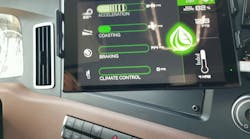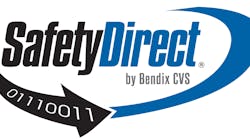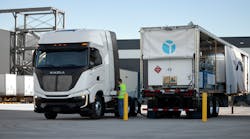There are opportunities out there that I would otherwise not have, had it not been for getting my Class A Commercial Driver’s License. One of those opportunities came this week, when I had the chance to drive the latest innovations in truck technology, with the retrofit Hyliion Class 8 hybrid-electric tractor. Plus, I rode along with managing editor David Brierley as he drove the new Dana Spicer electrified medium duty vehicle.
Hybrid-electric Class 8 tractor
Hyliion’s approach to the market is an interesting one: they are looking to serve the long-haul segment, particularly for more mountainous or hilly regions where the regenerative braking technology can be readily employed, extending the life of the brakes, improving fuel efficiency and optimizing vehicle performance. Plus, the electric auxiliary power unit offers additional fuel savings compared to a traditional diesel unit.
Retrofit on a Freightliner Cascadia, the 6X4HE electric-hybrid tractor included an electric APU, thermal management system, control unit and a Dana electric axle. The technology turns a traditional 6x4 axle configuration into a 6x2 hybrid, making the back drive axle a tag axle. The tag e-axle does one of three things while the vehicle is in operation: charges, assists, or does nothing. This truck does particularly well in hilly terrains because of the brake regeneration functionality. The bigger the hill its descending, the higher charging capacity. This is determined through the control unit with an algorithm used to analyze the topography of the route, which captures or applies energy to the vehicle.
Behind the wheel, the truck rides smoothly and has great pick-up. While I’m partial to manuals myself, the AMT provided smooth enough shifting and the truck accelerated quickly with great pick-up. Brakes were touchy, but mostly due to it being a new truck.
Driving in downtown Atlanta, even while bobtailing, I can tell you those lanes are narrow. Very narrow. I mean, driving a Toyota Camry would seem tight. But, no trees or road signs were harmed during my 10-minute drive.
The first stretch of road allowed for the best chance to see the driver performance app in action.
A "co-pilot" tablet situated on the dash featured a driver performance app with details on how well the driver is utilizing the acceleration and braking of the hybrid electric system. A driver receives a higher “Eco Score” the more mindfully he or she is operating the vehicle (e.g. gentle accelerations and no hard braking). The “gamification” focus allows drivers to obtain points for good driving behavior. A leaf icon on the app lights up different colors to show the status of the battery system - a blue leaf means the system is charging; a green leaf means "assist" mode, meaning the system is operating; and white means the system is doing nothing. (I took the keys from Hyllion’s resident-driver to the ride and drive event, Dan, and even got him a few extra points by the time we finished the three-mile loop.)
Click here to see a video demonstration of the user interface, or view embedded video link below.
Overall the truck rides quite similar to a traditional diesel - at least for the 10-minute drive in the city. Ultimately, it's designed to provide additional fuel savings and efficiency without sacrificing power.
About 15 trucks are in testing currently, but Gold confirms they are looking for more fleets who may be interested.
Medium duty full EV
In addition to the hybrid-electric Class 8, I also had the chance to ride along with managing editor David Brierley, when he took the new Dana Spicer Electrified Vehicle for a spin on the streets of Atlanta.
Over the last couple of years, Dana has gained stake in the electric propulsion market through acquisitions and partnerships. Case in point, the company purchased electric powertrain and system provider TM4 in July of 2018, which added motors, inverters and electronics capabilities to the company's portfolio. That's not to mention recent partnerships with hybrid electric and full-electric companies, like Hyliion and Lion Electric, respectively.
For this ride-and-drive, we rode along with Harry Trost, Senior Manager, Product Planning for Dana, who provided us details on the project.
Upfitted by Nordessa, the Peterbilt 220 urban beverage hauler included a combination of the Spicer S130 single reduction medium duty single drive axle and an SPL 100 driveshaft. The truck features a 650V system and 93 kWh battery.
Riding along in this fully electric vehicle, three of us could hold a conversation without shouting over the diesel engine. Minimal rattles from the cab, we mostly heard the turn signal and road noises when going over potholes through the city streets.
For power, the truck has a TM4 SUMO MD HV2600-6P high-torque/low-speed reluctance-assisted permanent magnet motor. This includes the CO 200 inverter, a versatile motor controller with significant current density. This means the system can provide 155 kW of continuous power, and 265 kW at peak.
David said he could tell when accelerating that the vehicle picked up speed quickly. Trost confirmed the power provided by the TM4 SUMO - at 2,036 ft-lbs - is equivalent to that of a Cummins ISX 15L diesel.
"The motor running in a direct drive configuration (running an axle) gives the same kind of performance [to a comparable diesel engine]," said Trost. "And you get that torque whenever you want."
Trost explained it this way: "Look at the torque speed profile of a motor: When you have 0 rpm on the motor, torque is at its peak. As you progress and the motor spins faster, it starts to lose torque. But it does the same thing a diesel would with a transmission when you shift. You take a step down, as you get faster and faster. It looks just like that kind of profile."
This electric truck platform is designed for urban beverage and package delivery. Trost confirmed the TM4 Sumo and CO 200 inverter have already been in use for some time, specified on some 12,000 transit buses in China, which have run more than 585 million kilometers (about 363.5 million miles).
Aside from silicon chips that will require periodic replacement for the converter, according to Trost, there is minimal maintenance for electric vehicles compared to their diesel counterparts. There are no additional fluids to monitor and change, and no belts that will become worn and need replacing. As many are aware, the braking systems of EVs are extended, significantly in some cases, due to the regenerative braking. That's because the regenerative system is actively stopping the vehicle when you're not accelerating, so the driver doesn't need to hit the brakes as often.
Operating the vehicle, David confirmed the truck had good pickup, and a noticeable decline in speed when he took his foot off the accelerator.
"In those transit buses, we’ve had experience where they went from three- to six-month brake replacement cycles, and then they don't touch them for three years," Trost confirmed. "Like you just experienced, you just don't touch the brakes. It’s not necessary anymore."
We even got to see the impact of telematics first-hand, since the truck required an over-the-air update to fix a communication issue on the truck. He said the back offices in Montreal were able to diagnose the issue, and send and update remotely.
"It was (an issue) with communication between the inverter, and then the power steering and the air compressors that had to be synchronized a little better," Trost explained. "They did an over-the-air update, and got it taken care of."






